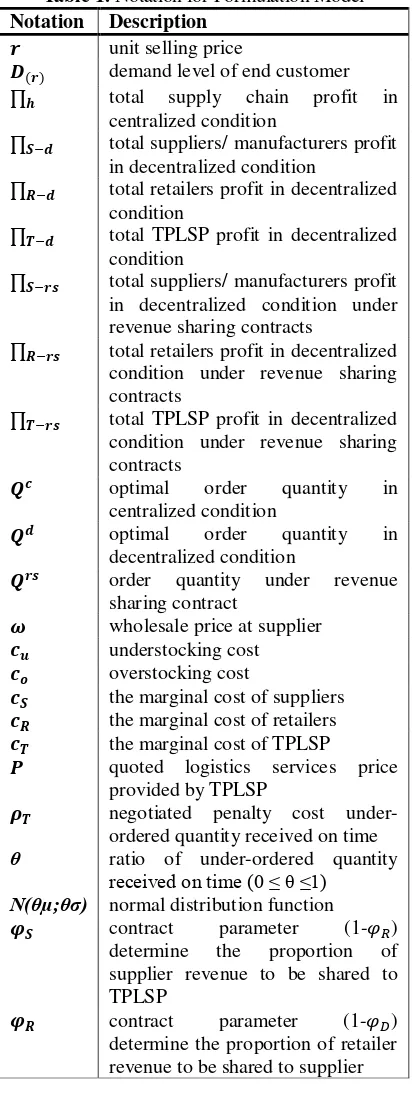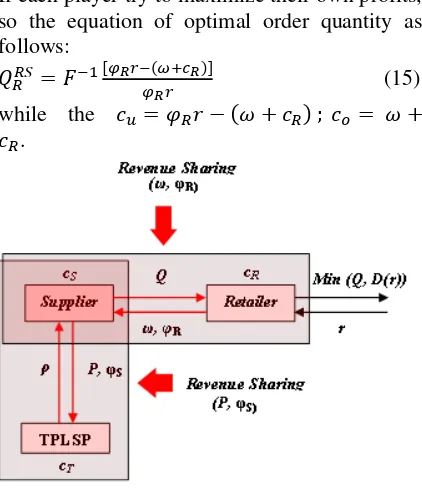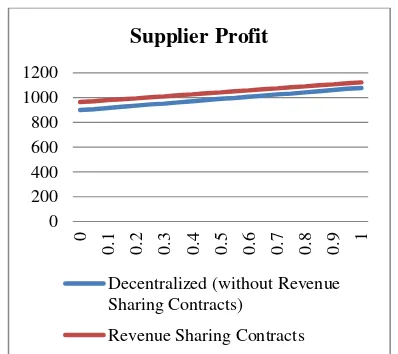Cite this Article As Narulidea, W., & Lathifah, A. (2018). Revenue Sharing Contract As Coordination Mechanism With
REVENUE SHARING CONTRACT AS COORDINATION
MECHANISM WITH THE IMPLEMENTATION OF LOGISTICS
OUTSOURCING IN DECENTRALIZED SUPPLY CHAIN
Winda Narulidea
1), Artya Lathifah
2)Logistics Engineering Department
1,2)
Universitas Internasional Semen Indonesia
Abstract
By making logistics outsourcing decision, companies have been able to improve the logistics performance, maintain focus on core business, and minimize distribution cost. However in decentralized condition, there is only limited control of the third party logistics service provider (TPLSP), whose logistics service performance affect the products availability, quality, price, and market share. In this research, a model is developed as coordination mechanisms with the implementation of logistics outsourcing in decentralized supply chain. Revenue sharing contract model is developed in the proposed model to coordinate the supply chain consisting of suppliers, TPLSPs, and retailers. Moreover the incentive and penalty scheme are implemented in accordance to the supply chain logistics service performance, so the risks and the necessary costs could be allocated to all players. To increase the desirability level of the contracts for all players, the contracts parameters are determined so that all players could obtain higher profit than in a common decentralized supply chain conditions, furthermore the win-win condition can be achieved. This paper provides new model of coordination mechanism in supply chain with logistics outsourcing and offers the incentive and penalty scheme into the basic model of revenue sharing contracts.Keywords: Coordination Mechanism, Logistics Outsourcing, Revenue Sharing Contracts, Supply Chain, Supply Contracts
1. Introduction
This study addresses the problem in the supply chain where the distributor supplies the product through third party logistics service provider (TPLSP) to the relatively long distance markets. Products are delivered by TPLSP to retailers for the selling season in the market. The problems came from the travel distance and the wide market penetration that must be covered in the products distribution. Especially in archipelagic country, such as Indonesia, the challenges are even greater to overcome the differences of
demographic and socio-economics
characteristics form its islands. In decentralized supply chain, manufacturers control over the interests of TPLSP cannot be done completely. There will be problems if carrier drivers from TPLSP do not deliver products as per the order
quantity and manufacturers’ distribution plans
to maintain market share and products quality received by the retailer. All players have a higher risk when there is no coordination among
* Corresponding author. Email : [email protected]
Published online at http://Jemis.ub.ac.id
Copyright ©2017 JTI UB Publishing. All Rights Reserved
supply chain [15]. Incentive alignment needs to be done to improve relationships that are mutually beneficial for all players in the supply chain. This study develops a coordination mechanism contract model among players with the involvement of logistics outsourcing in the supply chain. Revenue sharing contract according to Cachon and Lariviere [2] is a common supply chain contract model to determine contract parameters to coordinate the supply chain. They study a single retailer newsvendor model. Further research is developed by Giannoccaro and Pontrandolfo [10] about revenue sharing contracts model in multi echelon supply chain. It study the coordination mechanism of revenue-sharing contract scheme to coordinate three-stage supply chain which contains supplier, manufacturer and retailer.
Cite this Article As Narulidea, W., & Lathifah, A. (2018). Revenue Sharing Contract As Coordination Mechanism With balanced: the supermarket’s profit>farmer’s
profit>manufacturer’s profit. An incentive scheme is proposed to coordinate the supply chain. Under the revenue sharing contract
setting, the dairy industry’s total profit
increased by 12.49%. Then Sarathi et al. [24] develops an integrated revenue sharing and quantity discounts contract for coordinating a supply chain dealing with short life-cycle products. Li and Wang [16], and Dong and Li [7] are some of the other researches that using revenue sharing contract approach on different aspects such as inventory, competition, risk adverse retailers, etc.
Revenue sharing contract model in this research proposed for supply chain coordination with the logistics outsourcing as third party between supplier and retailer. In the supply chain, TPLSP is being responsible for distribution processes to retailers. Collaboration has the characteristics to make sharing of information, risk, and profit [17]. According Simatupang [25], information sharing and incentive alignment is a method of coordination that can affect the performance of the supply incentive and punishment scheme in accordance with the logistics performance of TPLSP. The values of the parameters in the model are determined to increase each player profit in the supply chain and the win-win conditions can be achieved.
2. Model
In the model, the supply chain system consists of three participants: manufacturers as the suppliers, TPLSP, and retailers as seen in Figure 1. Logistics outsourcing are implemented to perform logistics activity of the supplier. Products will be delivered by TPLSP from manufacturers/ suppliers for selling season in retailers. There are three possible conditions: (1) centralized; (2) decentralized; and (3) decentralized supply chain under revenue sharing contracts. In centralized condition, all roles of supply chain are owned and controlled under the same firm, while in decentralized condition all parties could be from varies firms that collaborated in the supply chain. In the last condition, revenue sharing contracts are
implemented for all players in decentralized supply chain. The retailers’ demand distribution is N(µ;σ). Then we denote F as the normal cumulative density function of N(µ;σ), and F-1
as the inverse normal cumulative density function. In this model, information of the demand distribution assumed to be known by all of players in supply chain.
Table 1. Notation for Formulation Model Notation Description
𝒓 unit selling price
𝑫(𝒓) demand level of end customer
∏𝒉 total supply chain profit in
centralized condition
∏𝑺−𝒅 total suppliers/ manufacturers profit
in decentralized condition
∏𝑹−𝒅 total retailers profit in decentralized
condition
∏𝑻−𝒅 total TPLSP profit in decentralized
condition
∏𝑺−𝒓𝒔 total suppliers/ manufacturers profit
in decentralized condition under revenue sharing contracts
∏𝑹−𝒓𝒔 total retailers profit in decentralized
condition under revenue sharing contracts
∏𝑻−𝒓𝒔 total TPLSP profit in decentralized
condition under revenue sharing contracts
𝝎 wholesale price at supplier
𝒄𝒖 understocking cost
𝒄𝒐 overstocking cost
𝒄𝑺 the marginal cost of suppliers
𝒄𝑹 the marginal cost of retailers
𝒄𝑻 the marginal cost of TPLSP
𝑷 quoted logistics services price provided by TPLSP
𝝆𝑻 negotiated penalty cost
under-ordered quantity received on time
θ ratio of under-ordered quantity received on time (0 ≤ θ ≤1)
N(θµ;θσ) normal distribution function
𝝋𝑺 contract parameter (1-𝜑𝑅)
determine the proportion of supplier revenue to be shared to TPLSP
𝝋𝑹 contract parameter (1-𝜑𝐷)
Cite this Article As Narulidea, W., & Lathifah, A. (2018). Revenue Sharing Contract As Coordination Mechanism With Figure 1. Model of logistics outsourcing for
suppliers in two-echelon supply chain.
2.1.Model in Centralized Supply Chain
The condition of centralized supply chain defines the ideal condition, which all the parties throughout the supply chain are under the same firms, so the whole decision makings are in the same objective; to get the optimal solution for the firm itself. In the centralized supply chain, the supply chain expected profit is given by:
∏ℎ= 𝑟 min[𝑄𝑐, 𝐷(𝑟)] − (𝑐𝑅+ 𝑐𝐷+ 𝑐𝑇)𝑄𝑐 (1)
The optimal order quantity is characterized by a balance between understock cost andoverstock cost. The understock and overstock cost is given as follows:
𝑐𝑢= 𝑟 − (𝑐𝑅+ 𝑐𝐷+ 𝑐𝑇) (2)
𝑐𝑜= 𝑐𝑅+ 𝑐𝐷+ 𝑐𝑇 (3)
(3) So the optimal order quantity is as shown
below:
𝑄𝑐 = 𝐹−1 𝑐𝑢
𝑐𝑢+𝑐𝑜= 𝐹
−1 𝑟−( 𝑐𝑅 + 𝑐𝐷 + 𝑐𝑇 )
𝑟 (4)
2.1.Model in Decentralized Supply Chain
Meanwhile under the decentralized condition, all the players make their own decision respectively. The supply chain performance become suboptimal, because each player wants to maximize their own profit, so the double marginalization occurred in the
supply chain.
The expected profit of retailer is given below:
∏𝑅𝑑= 𝑟 min[𝑄, 𝐷(𝑟)] − (𝜔 + 𝑐𝑅)𝑄 (5) The understock cost is calculated as 𝑐𝑢= 𝑟 −
(𝜔 + 𝑐𝑅) and the overstock cost 𝑐𝑜 =
(𝜔 + 𝑐𝑅), so that the optimal order quantity is
given as follow:
𝑄𝑑= 𝐹−1 𝑐𝑢
𝑐𝑢+𝑐𝑜= 𝐹
−1 [𝑟−(𝜔+𝑐𝑅)]
𝑟 (6) For supplier, the expected profit is given as follows:
∏𝑆𝑑= 𝜔𝑄𝑑−((1 − 𝜃)𝑃 − 𝜃𝜌𝑇+ 𝑐𝑆)𝑄𝑑 (7)
Likewise, for the TPLSP, the expected profit is given:
∏𝑑𝑇= ((1 − 𝜃)𝑃 − 𝜃𝜌𝑇)𝑄𝑑−𝑐𝑇𝑄𝑑 (8) The order of decision making is described below:
a. Supplier will determine the wholesale price 𝜔𝑖 to maximize their own profit as:
𝜔 = 𝑚𝑎𝑥𝜔∏𝑆𝑑
= 𝑚𝑎𝑥𝜔𝜔𝑄𝑑−((1 − 𝜃)𝑃 − 𝜃𝜌𝑇+ 𝑐𝑆)𝑄𝑑 (9)
b. Retailer will determine the optimal order quantity 𝑄𝑑 as:
𝑄𝑑= 𝐹−1 [𝑟−(𝜔+𝑐𝑅)]
𝑟 (10) c. The TPLSP will determine the logistics services price 𝑃 to maximize their own profit and can be modeled as:
𝑃 = 𝑚𝑎𝑥𝑃∏𝑑𝑇
= 𝑚𝑎𝑥𝑃((1 − 𝜃)𝑃 − 𝜃𝜌𝑇)𝑄𝑑−𝑐𝑇𝑄𝑑 (11)
2.2.Model in Decentralized Supply Chain under Revenue Sharing Contract
Under revenue sharing contract, retailers will share certain fraction of their revenue to the suppliers. The parameter
(1 − 𝜑𝑅) defines the certain fraction of retailers
revenue shared to suppliers. So the expected profit of retailers is given below:
∏𝑅𝑅𝑆= 𝜑𝑅 𝑟 (12) Likewise the suppliers will share certain fraction of their revenue to the TPLSP, so that the expected profit of suppliers is given as:
∏𝐷𝑅𝑆= 𝜑𝐷[(1 − 𝜑𝑅)(𝑟 𝑚𝑖𝑛[𝑄, 𝐷(𝑟)]) + 𝜔𝑄] −
(((1 − 𝛼)𝑃 + 𝛼𝑝𝑇) + 𝐶𝐷) 𝑄 (13)
Meanwhile for the TPLSPthe expected profit is given as:
∏𝑅𝑆𝑇 = (1 − 𝜑𝐷)[(1 − 𝜑𝑅)(𝑟 𝑚𝑖𝑛[𝑄, 𝐷(𝑟)]) +
𝜔𝑄] + ((1 − 𝛼)𝑃 + 𝛼𝑝𝑇) 𝑄 − 𝐶𝑇(𝑄)(14)
Supplie r
Retailer
TPLSP
Q
ρT P
Min (Q, D(r))
ω r
cT
Cite this Article As Narulidea, W., & Lathifah, A. (2018). Revenue Sharing Contract As Coordination Mechanism With If each player try to maximize their own profits,
so the equation of optimal order quantity as follows:
𝑄𝑅𝑅𝑆 = 𝐹−1 [𝜑𝑅𝑟−(𝜔+𝑐𝜑𝑅𝑟 𝑅)] (15) while the 𝑐𝑢= 𝜑𝑅𝑟 − (𝜔 + 𝑐𝑅) ; 𝑐𝑜 = 𝜔 + 𝑐𝑅.
Figure 2. Supply chain under revenue sharing contract.
To obtain coordination in the supply chain, the contract parameters 𝜑𝑅, 𝜑𝐷, 𝜔, and 𝑃 are designed so that the contract can effectively coordinates all the players. To get the order quantity as 𝑄𝑅𝑅𝑆 = 𝑄𝑐, so we obtain the equations as follow:
𝐹−1 [𝜑𝑅𝑟−(𝜔+𝑐𝑅)]
𝜑𝑅𝑟 = 𝐹
−1 𝑟−(𝑐𝑅+𝑐𝐷+𝑐𝑇)
𝑟
[𝜑𝑅𝑟−(𝜔+𝑐𝑅)]
𝜑𝑅𝑟 =
𝑟−(𝑐𝑅+𝑐𝐷+𝑐𝑇)
𝑟 (16)
𝜔 = (𝑐𝑅+ 𝑐𝐷+ 𝑐𝑇)𝜑𝑅− 𝑐𝑅 (17)
𝑃 = (𝑐𝑅+ 𝑐𝐷+ 𝑐𝑇)(𝜑𝑅+ 𝜑𝐷)(1 − 𝜑𝑅) − 𝑐𝑇 (18) Contract parameter 𝜑𝑅and 𝜑𝐷 range between 0 to 1, so we can obtain the equations as follow: 𝜑𝑅>𝑐𝑅+𝑐𝑐𝑅𝐷+𝑐𝑇 (19)
𝜑𝐷> 1
(1−𝜑𝑅) (𝑐𝑅+𝑐𝐷)
[𝑐𝑅+𝑐𝐷+𝑐𝑇]−(𝜑𝑅+𝜑𝐷) (20)
The order of decision making is described below:
a. Distributor will determine the wholesale price 𝜔 to maximize their own profit as:
𝜔 = 𝑚𝑎𝑥𝜔∏𝐷𝑟𝑠
𝜔 = 𝑚𝑎𝑥𝜔𝜑𝐷[(1 − 𝜑𝑅)(𝑟 𝑚𝑖𝑛[𝑄𝑟𝑠, 𝐷(𝑟)]) +
𝜔𝑄𝑟𝑠] − (((1 − 𝛼)𝑃 + 𝛼𝑝
𝑇) + 𝐶𝐷) 𝑄𝑟𝑠 (21)
b. Retailer will determine the optimal order quantity 𝑄𝑅𝑆 as:
𝑄𝑅𝑟𝑠= 𝑄𝑟𝑠= 𝐹−1 [𝜑𝑅𝑟−(𝜔+𝑐𝜑𝑅𝑟 𝑅)] (22)
c. The TPLSP will determine the logistics services price 𝑃 to maximize their own profit as:
𝑃 = 𝑚𝑎𝑥𝑃∏𝑟𝑠𝑇
𝑃
= 𝑚𝑎𝑥𝑝(1 − 𝜑𝐷)[(1
− 𝜑𝑅)(𝑟 𝑚𝑖𝑛[𝑄𝑟𝑠, 𝐷(𝑟)]) + 𝜔𝑄𝑟𝑠]
+ ((1 − 𝛼)𝑃 + 𝛼𝑝𝑇) 𝑄𝑟𝑠− 𝐶𝑇(𝑄𝑟𝑠)
(23)
3. Numerical Experiment
Numerical experiments are performed to clarify the proposed model and verify if the model could obtain win–win condition in supply chain. The contract parameters are determined to coordinate all players. As seen in table 2, the numerical experiments use the similar data from the basic model by Giannoccaro and Pontrandolfo [9]. For the purpose of comparing the expected profit, in this research using different ratio of
under-ordered quantity received on time (0 ≤θ≤1).
Table 2. Problem Data
Variable Value
𝑐𝑅 1
𝑐𝑇 2
𝑐𝑆 4
𝜔 2( P + cS ) = 16
𝑃 2𝑐𝑇 = 4
𝑝𝑇 2
price r 30
demand
D(r)
Normal distribution, μ=100, σ=30
Cite this Article As Narulidea, W., & Lathifah, A. (2018). Revenue Sharing Contract As Coordination Mechanism With the expected profit without RS contracts. It
means that RS contracts model has high desirability level for all supply chain players, which obtain higher profit than decentralized condition without RS contracts.
Figure 3. Retailer’s expected profit under RS and without RS contract
Figure 4. Supplier’s expected profit under RS and without RS contract
Figure 5. TPLSP’s expected profit under RS and without RS contract
Figure 6. Supply chain’s expected profit under RS and without RS contract
Not only from desirability level among all players in supply chain to collaborate into the contracts, even if we see from figure 6, the expected supply chain profit under RS contract could be higher than the ideal condition of centralized supply chain. It shows that the revenue sharing contract is helpful to coordinate the supply chain. Moreover, the incentive and punishment scheme for TPLSP could drive the punctuality of delivery. This scheme could increase logistics outsourcing performance in the supply chain. In the supplier
and retailer’s perspective, better coordination in
supply chain could obtain high profit, due to its benefit to improve the effectiveness and 0
200 400 600 800 1000 1200
Decentralized (without Revenue Sharing Contracts)
Revenue Sharing Contracts
0 200 400 600 800 1000 1200
0
0
.1
0
.2
0
.3
0
.4
0
.5
0
.6
0
.7
0
.8
0
.9 1 Supplier Profit
Decentralized (without Revenue Sharing Contracts)
Revenue Sharing Contracts
0 200 400 600 800
TPLSP Profit
Decentralized (without Revenue Sharing Contracts)
Revenue Sharing Contracts
0 500 1000 1500 2000 2500 3000
0 0.1 0.2 0.3 0.4 0.5 0.6 0.7 0.8 0.9 1
Supply Chain Profit
Decentralized (without Revenue Sharing Contracts)
Revenue Sharing Contracts
Cite this Article As Narulidea, W., & Lathifah, A. (2018). Revenue Sharing Contract As Coordination Mechanism With responsiveness to fulfil the customer demand.
4. Conclusion
Revenue sharing contracts model were developed to allocate the profit and to share the risk between players in the supply chain, specifically with the implementation of logistics outsourcing strategy in the supply chain. Moreover, to improve or maintain the performance of the TPLSP, in the model, there are penalty and incentive schemes in accordance to TPLSP performance. Numerical experiments were conducted to simulate the performance of the model to generate the expected profit of each player and the supply chain profit. From the expected profits obtained from numerical experiment, they show that the implementation of the revenue sharing contract model could gain the profit of each player and supply chain profit as a whole system. Moreover, the penalty and incentive schemes are applied in the model to improve the logistics outsourcing performance. They indicate that the revenue sharing contract model could be implemented in decentralized supply chain to coordinate the logistics outsourcing. With this coordination mechanism model, each player in the supply chain could act with the same objective to obtain the optimal solution for supply chain and it prevents double marginalization practice.
REFERENCES
[1] Ahumada O. Villalobos JR. A Tactical Model for Planning the Production and Distribution of Fresh Produce. Ann. Oper. Res,191(1):339–358;2011.
[2] Cachon GP. Lariviere MA. Supply Chain Coordination with Revenue-Sharing Contracts. Management Science, 51 (1):30–44;2005.
[3] Cai X, Chen J, Xiao Y, Xu X, Yu G. Fresh-product Supply Chain Management with Logistics Outsourcing. Omega, 41:752-765;2013.
[4] Chopra S, Meindl P. Supply Chain Management: Strategy, Planning, and Operation, Sixth Edition, Pearson Education. Pp. 433-466;2016.
[5] Chen, J., 2006. Study of revenue sharing contract in virtual enterprises. Journal of
Systems Science and Systems
Engineering, 15(1):95-113;2006.
[6] Chen YJ, Seshadri S. Supply chain structure and demand risk. Automatica, 42:1291-1299;2006.
[7] Dong S, Li R, 2009. Coordinate Supply Chain with Revenue-Sharing Contract under the Presence of Risk-Averse Retailer. Paper presented at the Proceedings of International Conference
on Information Science and
Engineering;2009.
[8] Donohue KL. Efficient Supply Contracts for Fashion Goods with Forecast Updating and Two Production Models. Management Science, 46(11):1397-1411;2000.
[9] Gerchak Y, Wang Y. Revenue-Sharing Versus Wholesale-Price Contracts in Assembly Systems with Random Demand. Production and Operations Management, 13(1),23-33;2004.
[10] Giannoccaro I, Pontrandolfo P. Supply chain coordination by revenue sharing contracts. Int. J. Production Economics, 89:131-139;2004.
[11] Höhn MI. Relational Supply Contracts. Lecture Notes in Economics and Mathematical Systems. Springer-Verlag, Berlin Heidelberg. Pp. 19-34;2010.
[12] Hou J, Zeng AZ, Zhao L. Coordination with A Backup Supplier Through Buy-Back Contract Under Supply Disruption. Transportation Research, 46: 881-895;2010.
[13] Hu TL, Sheu JB, Huang KH. A Reverse Logistics Cost Minimization Model for the Treatment of Hazardous Wastes. Transportation Research Part E: Logistics and Transportation Review, 38(6):457– 473;2002.
Cite this Article As Narulidea, W., & Lathifah, A. (2018). Revenue Sharing Contract As Coordination Mechanism With Operations Management,
3(4):293-305;2001.
[15] Lee HL, Padmanabhan V, Whang S. The Bullwhip Effect in Supply Chains, Sloan Management Review, 38(3):93-102;1997.
[16] Li X, Wang Q. Coordination Mechanisms of Supply Chain Systems. European Journal of Operational Research, 179(1):1–16;2007.
[17] Mentzer JT, Foggin JH, Golicic SL.
Collaboration: the Enablers,
Impediments, and Benefits. Supply Chain Management Review, 4(4):52‐ 58;2000.
[18] Pasternack B. Optimal Pricing and Returns for Perishable Commodities. Marketing Science, 4(2):166–176;1985.
[19] Petruzzi NC, Dada M. Pricing and the Newsvendor Problem: A Review. Operations Research, 47(2):183– 194;1999.
[20] Pujawan IN. Supply Chain Management, 2nd Edition, Guna Widya;2010.
[21] Putri RDA, Rusdiansyah A, Comparison Analysis Of Spanning Vs Pairwise Revenue Sharing Contract Model for Multi Stage Logistics System. Paper presented at the Proceedings of International Conference on Logistics and Maritime Systems;2013.
[22] Qian GX, Zhang YP, Wu JG, Pan YH. Revenue Sharing in Dairy Industry Supply Chain - A Case Study of Hohhot,
China. Journal of Integrative Agriculture, 12(12):2300-2309;2013.
[23] Quin Z, Yang J. Analysis of A Revenue Sharing Contract in Supply Chain Management. International Journal of Logistics Research and Applications 11(1):17-29;2008.
[24] Sarathi GP, Sarmah SP, Jenamani M. An Integrated Revenue Sharing and Quantity Discounts Contract for Coordinating A Supply Chain Dealing with Short Life-Cycle Product. Applied Mathematical Modelling, 38(15-16):4120-4136;2014.
[25] Simatupang T, Wright AC, Sridharan R. The Knowledge of Coordination for Supply Chain Integration. Business Process Management Journal,8(3):289-308;2002.
[26] Tsay AA. The Quantity Flexibility Contract and Supplier–Customer Incentives. Management Science, 45(10):1339–1358;1999.
[27] Van der Rhee B, Van der Veen J, Venugopal V, Vijayender RN. A new revenue sharing mechanism for coordinating multi-echelon supply chains. Operations Research Letters, 38:296-301;2010.



